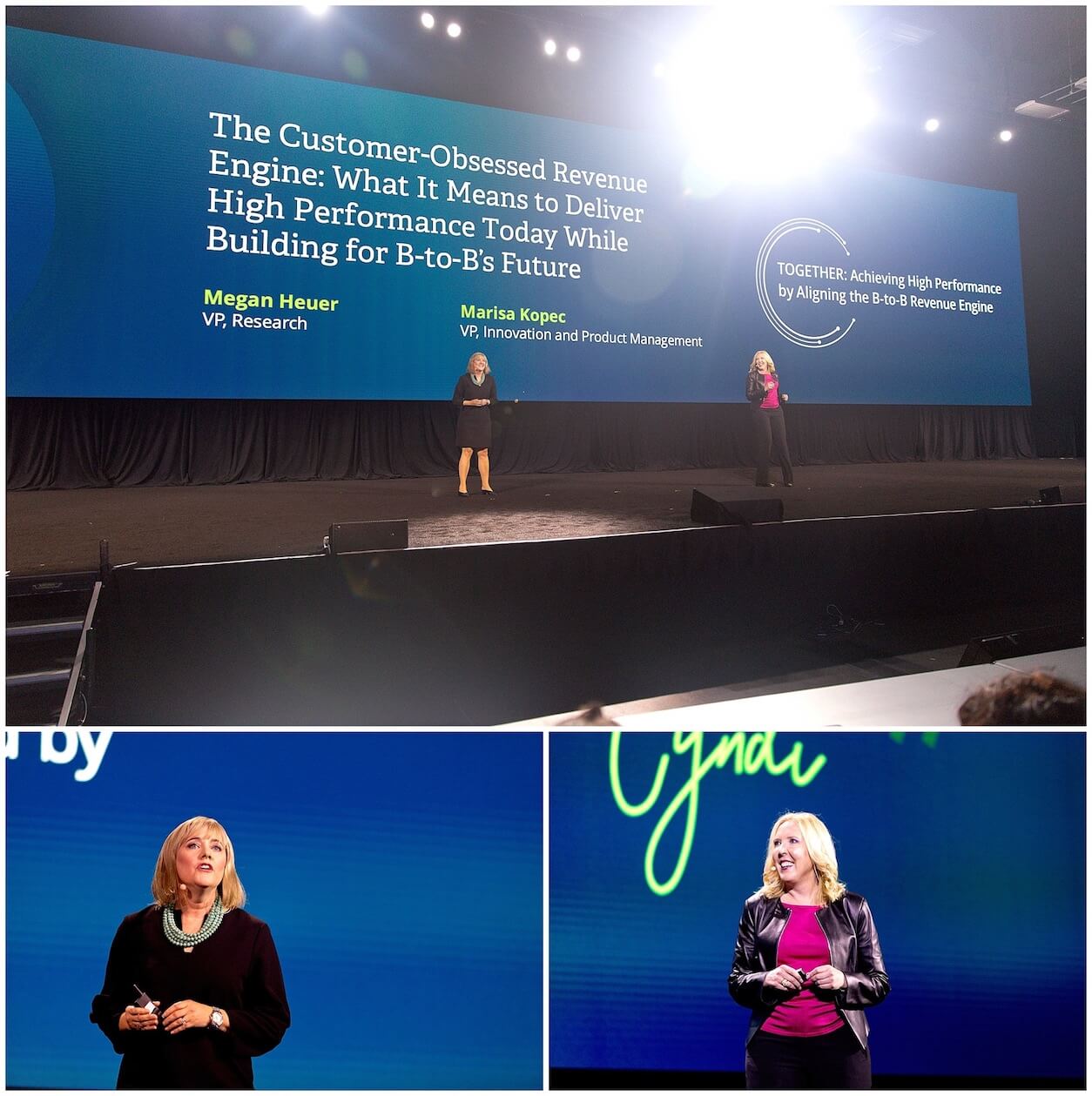The Revenue Engine: What Works Now? And What Does the Future Hold?
- To be successful in B2B, organizations need to know what good looks like today, and have an eye for the future
- This means carefully examining what elements must be in place now to operate effectively in sales, marketing and product – while also looking forward to emerging and disruptive trends in the market
- These requirements were the theme of “The Customer-Obsessed Revenue Engine: What It Means to Deliver High Performance Today While Building for B2B’s Future,” presented by Megan Heuer and Marisa Kopec at this year’s SiriusDecisions Summit in Austin
To be successful in B2B, organizations need to know what good looks like today, and have an eye for the future. This means carefully examining what elements must be in place now to operate effectively in sales, marketing and product – while also looking forward to emerging and disruptive trends in the market. These requirements were the theme of “The Customer-Obsessed Revenue Engine: What It Means to Deliver High Performance Today While Building for B2B’s Future,” presented by Megan Heuer and Marisa Kopec at this year’s SiriusDecisions Summit in Austin.

The two leaders walked on stage to the sound of Cyndi Lauper’s classic “Girls Just Want to Have Fun,” which, besides being an undeniable classic, presents a good case study for their topic. Cyndi Lauper was able to use her musical talents successfully in the 1980s, crafting songs that were fitting for the era – fun, colorful and loaded with synthesizers. But musical trends come and go, and tastes in the pop music world are fickle and fleeting – regardless of talent. Despite these changes, Lauper has found new ways to stay relevant and successful. As Marisa noted, five years ago she won 13 Tony awards for composing the music and lyrics to the Broadway Musical Kinky Boots – and she was the first woman to win on her own for Best Original Score.
So how does SiriusDecisions advise companies to embody this spirit of innovation and achievement?
Megan and Marisa used their presentation to introduce two key concepts that would be reinforced in additional sessions throughout the Summit for each B2B discipline: high performance and future vision. In other words, how can each functional team within the revenue engine assess its current state, and what trends will affect it in upcoming years?
Marisa explained that “a high-performing discipline or team performs better, faster and more efficiently than its peers,” but went on to explain that “the formula for high performance is not so simple; it’s a complex calculation of a lot of elements.”
The central part of this calculation is alignment between sales, marketing and product. But alignment takes chemistry – and, building on the idea of chemistry, Marisa walked the Summit audience through a periodic table of high performance. Structured like the periodic table of elements, the chart provides a high-level view of the lenses to look through to examine company, marketing, product, sales and customer engagement performance.
Marisa went on to explain why the customer piece is so important: “The customer compound contains the elements that define whether the customer is happy or not. Are there gaps in our customer experience? Are clients satisfied? Are they referring to us? Are they going to use us again?” The table as a whole comprises “the elements that make up a customer-obsessed B2B revenue engine. We need to look at these elements as a whole, not in functional silos – but together.”
From there, Megan took up the theme of future vision: “Many of the leaders we work with tell us they also want to know what they don’t know. Leaders want to know what’s coming tomorrow so they can plan for it today.” There’s a lot of change occurring in the business world and the world at large. But Megan emphasized that “change means opportunity.” She then named five trends that will shape the future of B2B: artificial intelligence (AI), accountability, atomization (e.g. niche audiences, hyperpersonalization), authenticity and adaptability. Although each of these trends has its own complexities and implications, Megan identified the common theme: the customer.
She then went through each trend and its impact on the customer in detail, beginning with AI. AI has a mixed reputation in 2019. Sure, it makes a lot of jobs faster and easier. But what does it mean for the workforce? Megan declared that “in fact, AI is job security for the revenue engine, but also job improvement. If we can stop spending time on the tasks AI does well, we can get back to what’s fun about B2B sales, marketing and product. That’s thinking about what matters to our customers and why and creating the resources and experiences that will stand out in a crowded market.”
She also talked about how important authenticity has become in the age of the customer, and made the point that “We can do good while doing well in B2B.” In other words, customers want companies to be transparent and genuine: “We see big brands taken down by bad behavior and small ones that turn into stars because of good behavior.” This means that a positive future vision goes beyond the concerns of profitability and into the realm of ethics and responsibility.
Megan closed by emphasizing the benefits of a forward-looking approach in terms of authenticity and adaptability: “We need to adopt a learning mindset one that’s open to new ideas and ways of doing things, not a fixed mindset that constantly looks to tear things down or say why they don’t work. Adaptability is about the optimism and ingenuity that have delivered so may breakthroughs in business and beyond.”